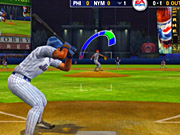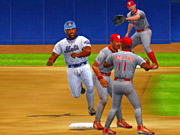EA Sports didn't release a baseball game in 2002. Instead, the company opted to shelve its popular Triple Play Baseball series and go back to the drawing board to design a more authentic baseball simulation. The end result is MVP Baseball 2003, a game that is a step in the right direction but has a few kinks that need to be ironed out.

The most interesting aspect of MVP Baseball 2003 is its emphasis on throwing the ball. When you toss a pitch or make a throw in the field, you can hold the button longer to put more force into the throw. In essence, you have the ability to vary the strength of your pitches and decide whether or not you'll execute a shotgun throw toward a base. MVP Baseball 2003 is the only game with this sort of control scheme, and it really does deepen the experience once you get the hang of it.
Pitching and batting are relatively straightforward, although they require you to focus on your timing more than other games. A visible cursor lets you aim the pitch around the plate. Once you've selected the pitch and built power into it, you need to lock in the accuracy of the pitch by pressing the pitch button again to stop a tick mark that will immediately start moving back across the strength meter. Your goal is to stop the tick mark within the green area. Too soon or too late and the pitch will go wild or crawl into the middle of the zone. In the batter's box, there aren't any cursors to deal with. Instead, the timing of your swing influences whether you'll get a base hit, foul the ball off, or ground out into the infield. By pressing a direction on the control stick, you also have the ability to push or pull the ball. Other positive aspects of the gameplay include hot and cold zones for hitters, the ability to queue up a stolen base attempt before the pitcher makes his delivery, and the option to control whether runners slide into a base or take it on their feet.
MVP Baseball 2003 makes every aspect of baseball a hands-on experience. Nonetheless, there are few issues and omissions that are too blatant to ignore. The CPU does a nice job of throwing pitches outside of the strike zone, but it won't swing at anything outside when it's up to bat. Players like Lee Stevens and Brandon Inge, who are both known for their terrible plate discipline, have the eyes of Barry Bonds here. Another concern is that it's easy to get extra-base hits. Line drives and bloop hits don't have enough bounce or velocity to them, which means that outfielders are chasing after the ball more often than they're taking it on the short hop. MVP is also missing a fair number of basic features that are common to baseball video games. You can't do simple things like take practice swings, warm up pitchers in the bullpen, or execute one-touch intentional walks--little things that go a long way toward duplicating the nuances of an actual baseball game.
In addition to the standard exhibition, season, postseason, and home run showdown play modes, MVP Baseball 2003 includes a franchise mode, but it isn't quite as detailed as what you'll find in other games. Common options such as randomized player drafts, expansion teams, and free agent signings are absent. Rather than assume the role of a general manager, your job is to accomplish a set of franchise goals specific to each team and win against your rivals to maintain momentum. The momentum aspect is nice because it increases the likelihood that your team will win when the CPU is simulating games for you. Franchise goals are interesting because they vary by team. You have 10 years to accomplish specific tasks, such as winning the World Series with the Giants, leading the league in runs with the Tigers, or going multiple seasons with a .500 win percentage in Tampa Bay.
Visually, the player graphics and camera angles are superb, but the stadiums could use a little work. There isn't much detail in the stands, and the spectators resemble cardboard cutouts, regardless of which angle you view them from. The players really look great, however. Their facial expressions change depending on the pitches that are thrown, so much so that in replays you can see batters scowl as they make contact for a hit. Throughout the game, the players' uniforms accumulate dirt and grass stains based upon the plays they make in the field. MVP Baseball 2003 is the first console baseball game to incorporate this sort of feature, and it's definitely a joy to see. The picture-in-picture baserunning cameras are a nice touch as well. Surprisingly, the PlayStation 2 version of the game looks a little better than the version that's available for the Xbox. The Xbox game uses the same textures that are used in the PS2 game, and they just don't look as crisp or vibrant when blown up to a higher resolution and blurred by antialiasing.

Audio is the game's strong suit. The ballpark atmosphere is identical in volume to what you'll hear while attending an actual MLB game. Stadium sound systems belt out familiar music and chants for the home team, which the audience responds to with intense vigor. If you have a subwoofer attached to your system, you can literally feel the spectators stomping on the bleachers. During close games and in late innings, the volume level of the audience kicks up to an even higher level. Player-specific chants, such as "I-chi-ro" and "Let's go Yankees, let's go" also bring an invaluable sense of realism to the ballpark environment. The play-by-play commentary provided by Duane Kuiper and Mike Krukow is steady throughout and frequently witty, although they have a tendency to repeat their comments about plays made in the field.
MVP Baseball 2003 is a solid reentry into the baseball market for EA Sports. It should satisfy players who don't care about all the miscellaneous nuances of the sport, or who aren't looking to immerse themselves in a complicated franchise mode.